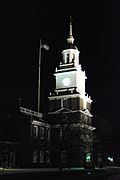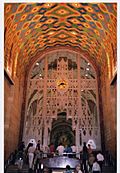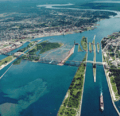List of National Historic Landmarks in Michigan facts for kids
Michigan is home to many amazing places that tell important stories about its past! These special spots are called National Historic Landmarks (NHLs). They show us Michigan's history from long, long ago, even before European settlers arrived, all the way up to World War II.
These landmarks include places important to Michigan's famous car-making, its busy shipping on the Great Lakes, and its mining history. There are 42 NHLs across Michigan, found in 18 of its 83 counties. You can find military forts like Fort Michilimackinac, religious sites like the St. Ignace Mission, and cultural spots like the Fox Theater and even Ernest Hemingway's childhood summer cottage. Sadly, two landmarks that were once on this list have been taken off because their buildings were torn down.
The National Park Service helps manage the National Historic Landmark Program. This group decides which places are special enough to become NHLs. They work with property owners and then the Secretary of the Interior makes the final decision. Both public places (like parks) and private properties (like homes) can become NHLs. This special title helps protect these places, sometimes by offering tax benefits or grants. If an owner doesn't want their property to be an NHL, it can still be listed as "eligible" for the title.
All NHLs are also part of a bigger list called the National Register of Historic Places (NRHP). Think of it like this: all NHLs are important across the whole country, while other NRHP places are important to a local area or just the state. Michigan's NHLs make up about 2% of all the historic places listed in the state.
Wayne County, where the car capital Detroit is located, has the most NHLs with 13. Emmet County and Mackinac County each have three. Some counties have two, and others have one. Michigan's first NHLs were chosen on October 9, 1960. The newest one was added on January 13, 2021. Eleven of Michigan's NHLs are actually "National Historic Landmark Districts," which means they cover a larger area, not just one building.
Contents
Michigan's Special Historic Landmarks
| National Historic Landmark | |
| National Historic Landmark District |
- The different colors help show which landmarks are large "districts" (covering an area) and which are single buildings or objects.
| Landmark name | Image | Date designated | Location | County | Description | |
|---|---|---|---|---|---|---|
| 1 |
Bay View |
(#72000613) |
Bear Creek 45°23′08″N 84°55′49″W / 45.385555555555555°N 84.93027777777779°W |
Emmet | This community started in 1876 as a Methodist summer camp. It later became a "chautauqua" (a place for education and culture) until 1915. It's a great example of these unique American community styles. | |
| 2 |
Calumet Historic District |
(#89001097) |
Calumet 47°17′45″N 88°27′14″W / 47.295833°N 88.453889°W |
Houghton | This area shows the history of the Calumet and Hecla Mining Company. It highlights how important and long-lasting the copper mining industry was in Michigan. | |
| 3 |
City of Milwaukee (Great Lakes Car Ferry) |
(#90002221) |
Manistee 44°15′34″N 86°18′58″W / 44.259324°N 86.316018°W |
Manistee | From 1931 to 1982, the City of Milwaukee was a ferry that carried cars across Lake Michigan. It's the only Great Lakes car ferry built before 1940 that still exists today. | |
| 4 |
Cranbrook |
(#73000954) |
Bloomfield Hills 42°34′23″N 83°14′57″W / 42.573055555555555°N 83.24916666666667°W |
Oakland | Cranbrook was designed as a beautiful place to learn. It's known as "one of the most important groups of educational and architectural structures in America." | |
| 5 |
Detroit Industry Murals, Detroit Institute of Arts |
(#14000279) |
Detroit 42°21′34″N 83°03′52″W / 42.359423°N 83.064414°W |
Wayne | These four murals at the Detroit Institute of Arts are famous artworks by Mexican artist Diego Rivera. They are considered some of the best modern art in the U.S. that show industrial themes. | |
| 6 |
Alden Dow House and Studio |
(#89001167) |
Midland 43°37′22″N 84°15′18″W / 43.622792°N 84.255121°W |
Midland | This house and studio belonged to the famous 20th-century architect Alden B. Dow. His unique work and connection to Frank Lloyd Wright made him nationally recognized. | |
| 7 |
Herbert H. Dow House |
(#76001033) |
Midland 43°37′08″N 84°15′10″W / 43.618847°N 84.252758°W |
Midland | From 1899 to 1930, this house was the home of Herbert H. Dow, who founded the Dow Chemical Company. | |
| 8 |
Durant-Dort Carriage Company Office |
(#75000943) |
Flint 43°01′03″N 83°41′43″W / 43.017443°N 83.695280°W |
Genesee | From 1895 to 1913, William C. Durant managed his car businesses from this office. The Durant-Dort Carriage Company helped start and fund the carriage and car industries, even helping Buick and General Motors get started. | |
| 9 |
Edison Institute |
(#69000071) |
Dearborn 42°18′17″N 83°13′55″W / 42.304722°N 83.23194°W |
Wayne | Henry Ford created the Edison Institute to show the history of the industrial age. The Henry Ford Museum, opened in 1929, is very important in the history of museums, especially outdoor village museums. | |
| 10 |
USS Edson (Destroyer) |
(#90000333) |
Bay City 43°36′50″N 83°52′10″W / 43.613953°N 83.869405°W |
Bay | The USS Edson is one of only two Forrest Sherman-class destroyers still around. It fought in the Vietnam War and became a museum ship in Michigan in 2013. | |
| 11 |
Fair Lane |
(#66000399) |
Dearborn 42°18′51″N 83°13′57″W / 42.31416665°N 83.2325°W |
Wayne | This 56-room house was the home of Henry Ford and his family from 1915 to 1950. It was designed with a mix of styles, including Prairie School and Late English Gothic. | |
| 12 |
Fisher Building |
(#07000847) |
Detroit 42°22′15″N 83°04′38″W / 42.370703°N 83.077310°W |
Wayne | Built in 1927 by the Fisher brothers, this skyscraper is a masterpiece by architect Albert Kahn. It was meant to be a beautiful gift to Detroit. | |
| 13 |
Ford Piquette Avenue Plant |
(#02000041) |
Detroit 42°22′07″N 83°03′55″W / 42.36861°N 83.065278°W |
Wayne | This factory was the first for the Ford Motor Company. Built in 1904, it's where the first Model T Ford was designed and made. This plant helped Henry Ford become famous in the car industry. | |
| 14 |
Ford River Rouge complex |
(#78001516) |
Dearborn 42°18′34″N 83°09′44″W / 42.30941°N 83.16212°W |
Wayne | This huge complex, built mostly between 1917 and 1927, is where Henry Ford first created a continuous assembly line for cars. It's known as "one of the industrial wonders of the world." | |
| 15 |
Edsel and Eleanor Ford House (Gaukler Pointe) |
(#79001164) |
Grosse Pointe Shores 42°27′21″N 82°52′26″W / 42.455833°N 82.873889°W |
Macomb | In 1926, Edsel Ford (Henry Ford's son) and his wife Eleanor hired Albert Kahn to design their home. It looks like cottages they saw in England's Cotswolds. The gardens were designed by Jens Jensen. The Fords moved in during 1929. | |
| 16 |
Fort Michilimackinac |
(#66000395) |
Mackinaw City 45°47′11″N 84°44′08″W / 45.786389°N 84.73555°W |
Emmet | This fort at the tip of Michigan's lower peninsula was first built by the French, then taken over by the British. During the American Revolutionary War, it was the only British fort on the Great Lakes with soldiers. | |
| 17 |
Fox Theater (Detroit) |
(#85000280) |
Detroit 42°20′16″N 83°03′05″W / 42.337792°N 83.051442°W |
Wayne | This amazing movie theater was designed by Howard Crane and built in 1928. It features a mix of decorations from different Far East cultures. | |
| 18 |
General Motors Building |
(#78001520) |
Detroit 42°22′09″N 83°04′32″W / 42.369254°N 83.075693°W |
Wayne | Finished in 1923, this is the oldest existing headquarters for General Motors in Detroit. It represents one of the world's largest car companies. | |
| 19 |
General Motors Technical Center |
(#00000224) |
Warren 42°30′48″N 83°02′16″W / 42.51333°N 83.03778°W |
Macomb | This research center for General Motors was completed in 1955. It's praised as one of the best industrial buildings of its time. | |
| 20 |
Grand Hotel |
(#72000637) |
Mackinac Island 45°50′56″N 84°37′33″W / 45.8488968693°N 84.6259042142°W |
Mackinac | Built in the late 1800s, this large wooden hotel is one of the few left from that time. It sits on a bluff overlooking Lake Huron and is called "the American dream of "a summer place."" | |
| 21 |
Guardian Building |
(#89001165) |
Detroit 42°19′45″N 83°02′46″W / 42.329153°N 83.046122°W |
Wayne | This 1928 building was designed to feel welcoming to customers. It's an example of how skyscrapers changed in the U.S., using Arts and Crafts tiles on a steel frame. | |
| 22 |
Ernest Hemingway Cottage |
(#68000026) |
Walloon Lake 45°16′41″N 84°59′58″W / 45.2781756787°N 84.9993079874°W |
Emmet | From 1904 to 1921, this cottage was the summer home of famous author Ernest Hemingway. Here, he learned to love the outdoors, which became a big part of his books. | |
| 23 |
Highland Park Ford Plant |
(#73000961) |
Highland Park 42°24′38″N 83°06′02″W / 42.410687°N 83.100528°W |
Wayne | This plant, designed by Albert Kahn, is considered the "birthplace of the moving assembly line". Car making started here in 1910 and continued until 1927. | |
| 24 |
Lightship No. 103 "HURON" |
(#76001974) |
Port Huron 42°59′15″N 82°25′36″W / 42.98737°N 82.42667°W |
St. Clair | Lightships were used on the Great Lakes to mark dangerous areas where lighthouses couldn't be built. The Huron is the only one of its kind left and was the last one used on the Lakes. | |
| 25 |
Mackinac Island |
(#66000397) |
Mackinac Island 45°52′00″N 84°38′00″W / 45.86667°N 84.63333°W |
Mackinac | This island was very important for the early fur trade because of its location in the Great Lakes. It still has many buildings from the fur industry. Its importance was settled after the 1814 Treaty of Ghent. | |
| 26 |
Marshall Historic District |
(#91002053) |
Marshall 42°16′19″N 84°57′51″W / 42.271944°N 84.964167°W |
Calhoun | Marshall was once considered to be the state capital. It later became a center for railroads and medicine production. Much of its original architecture from the 1860s still remains. | |
| 27 |
McGregor Memorial Conference Center |
(#10001023) |
Detroit 42°21′34″N 83°04′15″W / 42.359519°N 83.070722°W |
Wayne | Completed in 1958, this was architect Minoru Yamasaki's first big project after his trip to Japan. It was praised by architecture magazines as "delightful" and "refreshing." | |
| 28 |
Meadow Brook Hall |
(#79001166) |
Rochester Hills 42°40′19″N 83°12′04″W / 42.671944°N 83.20111°W |
Oakland | This large Tudor revival estate belonged to Matilda Dodge Wilson and was built in the 1920s. It's one of the largest historic houses in the country. | |
| 29 |
Michigan State Capitol |
(#71000396) |
Lansing 42°44′01″N 84°33′14″W / 42.733661°N 84.553911°W |
Ingham | Designed by architect Elijah E. Myers, this building was constructed between 1872 and 1878. It was the first state capitol building to be modeled after the US Capitol Building. | |
| 30 |
Mies van der Rohe Residential District, Lafayette Park |
(#96000809) |
Detroit 42°20′22″N 83°01′55″W / 42.33940°N 83.03190°W |
Wayne | This area has the largest collection of buildings by Mies van der Rohe in the world. They are great examples of the International Style of architecture. | |
| 31 |
Milwaukee Clipper (Passenger Steamship) |
(#83003570) |
Muskegon 43°13′19″N 86°17′45″W / 43.221944°N 86.295833°W |
Muskegon | This passenger steamship, first called Juniata, was built in 1905. After being rebuilt in 1940, it was renamed Milwaukee Clipper. It still has its original 1905 engines. | |
| 32 |
Minong Copper Mining Historic District |
(#100006259) |
West of McCargoe Cove campground 48°04′58″N 88°43′35″W / 48.082778°N 88.726389°W |
Keweenaw | The Minong Mine site has very old copper mining pits, possibly 4500 years old! It also has remains of a 19th-century copper mine that operated for ten years. | |
| 33 |
North Manitou Island Lifesaving Station |
(#98001191) |
Sleeping Bear Dunes National Lakeshore 45°07′09″N 85°58′39″W / 45.119194°N 85.977517°W |
Leelanau | This station helped save lives on the Great Lakes from 1854 to 1932. It's the only one left of nearly 200 stations that once existed. These stations helped shipwreck victims. | |
| 34 |
Norton Mound group |
(#66000396) |
Grand Rapids 42°56′12″N 85°43′19″W / 42.936581°N 85.721981°W |
Kent | From about 400 B.C. to A.D. 400, this was an important center for the Hopewellian culture in the Great Lakes area. It's one of the best-preserved examples. | |
| 35 |
Parke-Davis Research Laboratory |
(#76001039) |
Detroit 42°20′06″N 83°00′52″W / 42.3349347044°N 83.0144806964°W |
Wayne | Built in 1902, this was the first industrial research lab in the U.S. specifically for drug research. It helped start the modern way of developing new medicines. | |
| 36 |
Pewabic Pottery |
(#71000430) |
Detroit 42°21′42″N 82°58′52″W / 42.361567°N 82.981083°W |
Wayne | This 1907 building is the studio of ceramic artist Mary Chase Perry Stratton. Her work in the Arts and Crafts movement improved American pottery and is shown in many famous buildings. | |
| 37 |
Quincy Mining Company Historic District |
(#89001095) |
Hancock 47°08′07″N 88°34′33″W / 47.135278°N 88.57583°W |
Houghton | This historic area shows the U.S. copper industry from the mid-1800s to 1920. It represents company towns, mining technology, and different ethnic groups who settled there. | |
| 38 |
Badger (Car Ferry) |
(#09000679) |
Ludington 43°56′57″N 86°27′04″W / 43.949167°N 86.451111°W |
Mason | The Badger is the last Great Lakes rail ferry ever built and the last one still working. It has unique engines that are the only ones of their kind still running. | |
| 39 |
St. Clair River Tunnel |
(#70000684) |
Port Huron 42°57′29″N 82°25′59″W / 42.958118°N 82.43298°W |
St. Clair | This tunnel was a big step forward in railroad technology. When it was finished in 1891, it was the first underwater tunnel in North America for full-size trains. | |
| 40 |
St. Ignace Mission |
(#66000398) |
St. Ignace 45°52′11″N 84°44′38″W / 45.869651°N 84.743945°W |
Mackinac | This park was once a mission started by French priest Jacques Marquette, who was buried here in 1677. A new mission was built later and moved to St. Ignace in 1954. | |
| 41 |
St. Marys Falls Canal |
(#66000394) |
Sault Ste. Marie 46°30′11″N 84°21′17″W / 46.50305°N 84.35472°W |
Chippewa | The original canal of the Soo Locks, built in 1855, allowed ships to travel between Lake Superior and Lake Huron. This helped move resources from Michigan's Upper Peninsula to cities in the Lower Peninsula. | |
| 42 |
USS Silversides (Submarine) |
(#72001566) |
Muskegon 43°13′47″N 86°19′58″W / 43.229739°N 86.332830°W |
Muskegon | The Silversides is the most decorated U.S. submarine still existing. It sank 23 ships during World War II and earned many awards. It patrolled the Pacific Ocean to stop supplies from reaching the Japanese. |
NHLs That Moved from Michigan
Some landmarks were once in Michigan but have since moved to other states.
| Landmark name | Image | Date designated | Location | County | Description | |
|---|---|---|---|---|---|---|
| 1 |
Columbia (Steamer) |
(#79001171) |
Buffalo, New York 42°51′39″N 78°51′44″W / 42.860878°N 78.862312°W |
Erie | This passenger steamship carried people to Bois Blanc Island. It's one of the last ships of its kind. In 2015, it moved to Buffalo, New York. |
Former NHLs in Michigan
These landmarks were once in Michigan and had the special NHL status, but they are no longer considered landmarks because the sites were changed or torn down.
| Landmark name |
Image |
Date designated |
Date moved or delisted |
Locality |
County |
Description |
|
|---|---|---|---|---|---|---|---|
| 1* | Lincoln Motor Company Plant |  |
June 2, 1978 | April 4, 2005 | Detroit | Wayne | Henry M. Leland bought this factory in 1917 and made it much bigger to produce engines for World War I. After the war, Leland started the Lincoln car line here. Henry Ford bought the company in 1922. Most of this factory was torn down in 2002–03, so it lost its landmark status. |
| 2* | Reo Motor Car Company Plant |  |
June 16, 1978 | July 31, 1985 | Lansing | Ingham | After leaving Oldsmobile, Ransom E. Olds started the Reo Motor Car Company at this plant in 1904. Reo made many new things in car manufacturing. The factory was torn down in 1980, so it lost its landmark status in 1985. |
| 3* | SS Ste. Claire |  |
July 6, 1992 | December 11, 2023 | Detroit | Wayne | The Ste. Claire carried passengers to Bois Blanc Island from 1910 to 1991. It was designed by naval architect Frank E. Kirby. The ship was removed from the National Historic Landmark list in 2023. |
See also












































